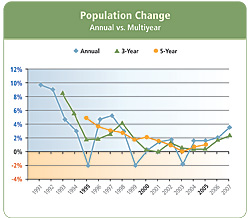ArcUser Online
These examples may appear extreme. However, multiyear averages are to be used for the smallest areas, counties with populations less than 65,000 and subcounty areas such as tracts and block groups that are subject to extreme changes in population. Sudden growth from housing development is the most common change, but sudden loss of population due to the closing of a military base or factory or a natural disaster also happens. The graph in Figure 1 shows the variability of annual population trends that are calculated from point estimates and the leveling effect of three- and five-year averages. This county had a base population of 43,700 in 2000. The estimated changes in multiyear averages occasionally coincide with the annual estimates. However, obvious variations from the smoothed trend line are lost. Significant shifts in the population are exactly the events that require current information about changes in demographic characteristics. Aggregate data from multiyear averages must be complemented by annual data on population change if the data user is to interpret the averages correctly. If the understanding of multiyear estimates places this burden on the data user, why bother? The design of the ACS precludes any reporting of the sample data for small areas without multiyear averages. Pooling the monthly surveys to create a multiyear period estimate is necessary to reduce the variance of the sample estimates for small areas. The reduction in sample variance can only be viewed with data for areas that are large enough to support annual ACS estimates, but the effect is evident, even in larger areas. The table in Example 4 displays single-, three-, and five-year averages on median home value for Franklin County, Ohio. The base of this variable is owner-occupied units (259,142, +/-2,329), from the 2001-2005 ACS average. The decrease in variance from one- to three- to five-year estimates is apparent; so is the "averaging" effect on median home value. In this example, the sample estimate increased at a steady rate from $121,500 in 2001 to $148,400 in 2005, about 5.5 percent annually. Therefore, the three- and five-year averages are at least consistent with the annual estimates. Unfortunately, this information will not be available for areas with a population less than 65,000. Only averages are to be reported from the pooled ACS samples. Although change can be tracked from each annual release of ACS data, estimates of change from overlapping multiyear averages are imprecise at best. If the one-year estimates are questionable for small areas, then one or two years of change in multiyear averages are equally uncertain.
Time is a specific reference point, even in the world of forecasts and estimates where data may represent a future point in time or incomplete information. The United States census has a designated Census Day, April 1 of years ending in zero. Current estimates commonly refer to July 1, a midyear point. Forecasts or projections represent a designated future date, usually July 1. These point estimates, or projections, enable simple calculation of change between two points in time. For data users who are accustomed to analyzing point data from a census, an estimate, or a forecast, the switch to a moving average is a reality shift. Current estimates of change are available from the ACS if you are willing to wait three to five (nonoverlapping) years. Questions from readers are welcome. Please send them to lwombold@esri.com. Other Articles in This SeriesThree other articles by Lynn Wombold have been published on this subject in ArcUser magazine. "Changes and Challenges—Understanding American Community Survey data." Oct.-Dec. 2007 issue of ArcUser "Sample Size Matters—Caveats for users of ACS tabulations." Winter 2008 issue of ArcUser "Examining Error—Consider the effect of sample size and error source when using census data." Spring 2008 issue of ArcUser About the AuthorLynn Wombold, chief demographer at Esri, manages data development for Esri including the processing of census data and the development of unique databases, such as demographic forecasts, consumer spending, Retail MarketPlace, and the Community Tapestry market segmentation system, as well as the acquisition and integration of third-party data. She is also responsible for custom analysis and modeling projects. With more than 31 years of experience, her areas of expertise include population estimates and projections, state and local demography, census data, survey research, and consumer data. Prior to joining Esri, she worked for CACI Marketing Systems and was the senior demographer at the University of New Mexico. Wombold holds degrees in sociology with a specialty in demographic studies from Bowling Green State University in Ohio. She has received CACI's Eagle Award for Technical Excellence and Encore Achievers. The author of numerous articles for industry publications, she frequently presents papers on demography. |
